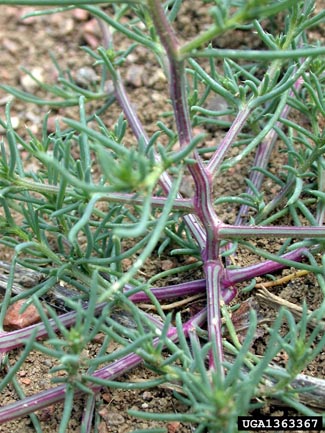Russian Thistle

Common Name(s):
Russian Thistle
Tumbleweed
Scientific Name:
Salsola tragus L.
Scientific Name Synonyms:
Salsola iberica Sennen & Pau
Salsola kali L.
Symbol:
SATR12
Description:
Life Span: Winter annual
Origin: Introduced
Season: Warm
Growth Characteristics: A 1 to 3 feet tall forb, very branched and round in shape. It can be up to 5 feet wide. At first the plant is soft and succulent, but it becomes rigid and spiny with maturity. It flowers July to October and reproduces from seed.
Flowers/Inflorescence: Small, papery, and inconspicuous, growing singly or several together in the axils of the spiny leaf clusters. The flowers are greenish to pinkish-white.
Fruits/Seeds: Seeds are round and snail-shaped, white to pink colored.
Leaves: Linear, spine-tipped, alternate, and white to pink colored. They usually become bright red in late summer and fall.
Ecological Adaptions:
Russian thistle is found in fields, overgrazed pastures, roadsides, waste places, and disturbed sites. It does best on high, dry land if other plants are not crowding it. Russian thistle is quite drought resistant.
Soils: Found on nearly all soil types. It is salt resistant, so it does grow well on alkali soils.
Associated Species: Curlycup gumweed, sunflower, cocklebur, cheatgrass, and big sagebrush.
Uses and Management:
Russian thistle provides fair forage for cattle and sheep in the early spring, becoming worthless with maturity because of the sharp-pointed leaves. If it turns black at maturity and is softened by moisture it is good winter feed. Livestock can suffer injury from the leaves, which may accumulate nitrates, and may contain oxalates. It is an indicator of overuse and unhealthy rangeland. It does not compete well with other plant species.
When Russian thistle is mature, it pulls free of the soil and blows away, hence the name "tumbleweed." This is how the seed is spread.
Young shoots of Russian thistle can be used as a potherb and seeds can be ground into meal. It is sometimes used for Christmas decoration.
Russian thistle is sometimes harvested for hay and silage. Russian thistle hay is credited with saving the beef cattle industry in Canada and the United States during the Dust Bowl era, when conventional hay crops failed and no other feed was available for starving animals.

